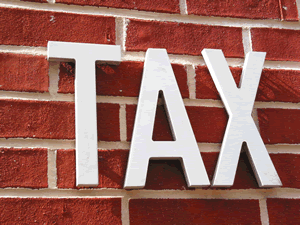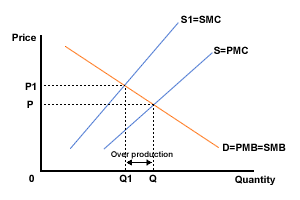Taxes and subsidies
The use of taxes and subsidies to tackle the problem of externalities is a market-based method of control as it works through the price system, i.e. through the impact of changes in prices.
If negative externalities exist, and there is allocative inefficiency at the free market price because SMC is greater than price and overproduction is occurring, then the appropriate solution would be to tax the good; if, on the other hand, the market is under-producing because positive externalities are not being taken into account, it would be appropriate for the government to grant a subsidy.
Taxes
 There are two types of tax which may be applied to address the problem of negative externalities: a tax set equal to each firm's marginal external costs and an environmental or 'green' tax.
There are two types of tax which may be applied to address the problem of negative externalities: a tax set equal to each firm's marginal external costs and an environmental or 'green' tax.
The policy of taxing firms according to the marginal external costs that they impose on society can be illustrated using figure 1 below. In this example we assumed that a firm was dumping waste products into a river. The government would have to assess the cost to society of such an action, and impose a tax on the offending firm equal to the value of the marginal external cost (or negative externality); in this case the tax would internalise the externality by making the polluter pay. The levying of such a tax would shift the supply curve from S to S1,which would increase the market price to OP1, and cause the level of output to fall to OQ1, where P = SMC and allocative efficiency is achieved.

Figure 1 Negative externalities - dumping of waste
An environmental tax could be imposed either on a product responsible for creating pollution, or on the inputs to an industry which have caused environmental damage e.g. carbon producing fuels, which are believed to play the major role in the process of global warming. The aim of a carbon tax on each unit of carbon in fossil fuels would be to: raise the price of those sources of power with high carbon contents, thus encouraging a switching to power sources causing lower CO2 emissions; encourage greater conservation of energy in general; and stimulate the search for more environmentally-friendly technologies.
Issues arising from the tax/subsidy approach
Advocates of this approach would argue that it permits the forces of demand and supply to operate. At the same time generators of negative externalities are induced to 'clean-up their act' because the less pollution they create, the less their tax liability; and conversely, grants and subsidies encourage greater output and consumption of those goods involving net social benefits.
In practice various difficulties are likely to arise:
- for the tax solution to work in the way indicated in figure 1 above, the exact value of the marginal external cost must be established so that taxes, of exactly the right size can be applied; in reality it is not only extremely difficult to identify external costs, but it also an extremely arbitrary matter trying to ascribe a monetary value to them e.g. how should the emission of black fumes into the air from an industrial chimney be assessed?
- from an environmental point of view a tax on pollution does not solve the problem, as pollution is still allowed to continue; the tax merely provides a market-led inducement to firms to find cleaner ways of producing so as to reduce their costs; moreover, the unwilling third parties who receive pollution as a negative externality are not in any way compensated.
- taxation of pollution would require regular monitoring of pollution emissions and as offending firms are likely to be generating different quantities and types of pollution, such monitoring is likely to be administratively complex and very costly.
- distortions and inefficiencies might arise in terms of the cost of collecting a pollution tax, the inevitable temptation by the less scrupulous to evade paying it altogether and the possibility of an inflationary impact on the price level.
